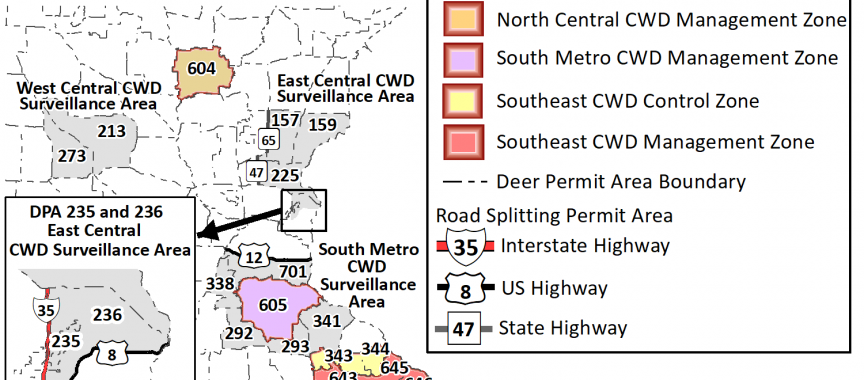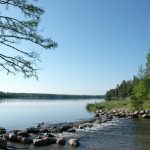Changes for 2020 include voluntary sampling in affected areas, a new management zone and new surveillance areas
In the ongoing strategy to manage chronic wasting disease in Minnesota’s wild deer, the Department of Natural Resources has made several changes to this year’s deer hunting regulations. CWD sampling is voluntary for 2020, with hunters submitting samples from their deer at unstaffed sampling stations that facilitate social distancing during the COVID-19 pandemic.
Hunters will also find a new management zone and new surveillance areas in the regulations, after CWD was detected in wild and farmed deer in new areas. The DNR continues to monitor and manage CWD in an effort to keep prevalence low and reduce spread of the disease.
“We are committed to keeping our wild deer healthy, while also facilitating social distancing for hunters and our staff,” said Michelle Carstensen, DNR’s wildlife health program supervisor. “Deer hunters are essential in our surveillance efforts. They’ve been great partners, and we’re confident that their continued participation will help us collect the needed samples to detect disease on the landscape.”
Hunters in disease management zones, control zones or surveillance areas can get their deer checked throughout the season by dropping off the head of deer 1 year of age or older at a self-service sampling station. Hunters are encouraged to submit samples in these areas and zones to help monitor the spread of the disease in wild deer.
Deer harvested in the disease management zones or control zone will have self-service sampling stations available for all seasons. Any hunter who has harvested a deer in a CWD surveillance area can get their deer tested when self-service sampling stations are not available. Current information for station availability is on the CWD webpage. Hunters can call the local DNR wildlife office within that surveillance area to arrange for their deer to be sampled for CWD.
Full lists of self-service sampling stations, as well as dumpster locations to assist with carcass movement restrictions will be available at mndnr.gov/cwd.
Mandatory carcass movement restrictions
Mandatory carcass movement restrictions are in effect for all CWD management and control zones, in southeastern Minnesota and the south-metro area. Whole carcasses cannot leave these zones until a “not detected” test result is received. If hunters do not submit their deer for sampling, they must debone and quarter their deer, in order to transport their harvest. No carcass movement restrictions are in place in CWD surveillance areas, where the disease has not been discovered in wild deer.
“While sampling is voluntary, we want to underscore that our carcass movement restrictions remain mandatory in disease management zones,” Carstensen said. “This action is critical in keeping the disease from spreading farther in the state.”
Management zone and surveillance area changes
Based on discoveries of CWD in wild and captive deer in new areas last year and this spring, the DNR will monitor and manage the disease in these newly created areas, as guided by its CWD response plan.
- South-metro CWD management zone—created after detection of CWD in a wild deer in Dakota County. This zone is named deer permit area 605.
- South-metro surveillance area—created after detection of CWD in a wild deer in Dakota County. The area is permit areas 292, 293, 338, 341 and 701.
- East-central surveillance area—created after detection of CWD in a deer farm in Pine County. This area is portions of permit areas 157, 225, 235, 236 and all of permit area 159.
- West-central surveillance area—created after detection of CWD in a deer farm in Douglas County. The area is permit areas 213 and 273.
The north-central management zone (DPA 604), southeast management zone (DPAs 643, 645, 646, 647, 648, 649 and 655) and southeast control zone (DPAs 255, 343 and 344) remain the same as last year. There will be no additional sampling in the central CWD surveillance area this year, which concluded its three-year sampling effort last fall with the disease not detected.
The DNR creates management zones when CWD is detected in a wild deer, to contain the infection and reduce the prevalence in the area, and collect samples to monitor the disease. In management zones, hunters are able to harvest as many antlerless deer as they wish with the purchase of a disease management permit for $2.50 for each deer. The control zone borders the southeast CWD management zone to help prevent further spread of disease. Surveillance areas are created to collect samples to determine how widespread the disease is in the local wild deer population, typically when CWD is found in a captive deer facility.
Barbara Keller, DNR’s big game program leader, said the DNR continues to use three management tools to reduce the risk of CWD: reducing deer densities, using feeding and attractant bands to reduce contact between deer, and restricting carcass movement. “These tools are our best chance at limiting the spread of the disease in wild deer.”
Feeding ban expansion
On July 1, deer feeding and attractant bans were expanded to include areas in and near the metro area when six additional counties (Dakota, Hennepin, Ramsey, Rice, Scott and Washington) were added to deer feeding and attractant bans. More information, including a full list of the counties under restrictions, can be found on the deer feeding ban webpage.
Last modified: 08/25/2020











